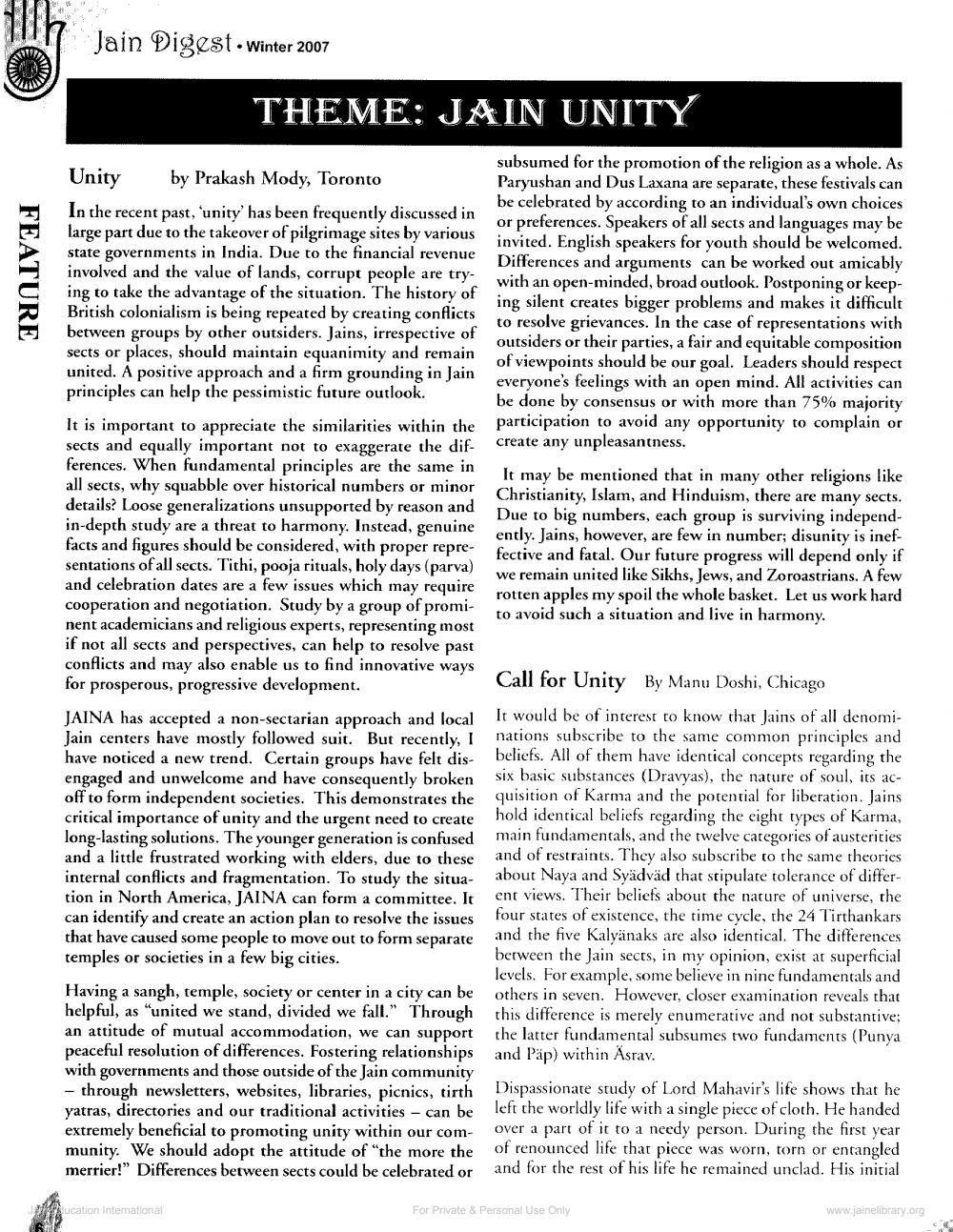Book Title: Jain Digest 2007 11 2 Author(s): Federation of JAINA Publisher: USA Federation of JAINA View full book textPage 8
________________ FEATURE Jain Digest Winter 2007 THEME: JAIN UNITY Unity by Prakash Mody, Toronto In the recent past, 'unity' has been frequently discussed in large part due to the takeover of pilgrimage sites by various state governments in India. Due to the financial revenue involved and the value of lands, corrupt people are trying to take the advantage of the situation. The history of British colonialism is being repeated by creating conflicts between groups by other outsiders. Jains, irrespective of sects or places, should maintain equanimity and remain united. A positive approach and a firm grounding in Jain principles can help the pessimistic future outlook. It is important to appreciate the similarities within the sects and equally important not to exaggerate the differences. When fundamental principles are the same in all sects, why squabble over historical numbers or minor details? Loose generalizations unsupported by reason and in-depth study are a threat to harmony. Instead, genuine facts and figures should be considered, with proper representations of all sects. Tithi, pooja rituals, holy days (parva) and celebration dates are a few issues which may require cooperation and negotiation. Study by a group of prominent academicians and religious experts, representing most if not all sects and perspectives, can help to resolve past conflicts and may also enable us to find innovative ways for prosperous, progressive development. JAINA has accepted a non-sectarian approach and local Jain centers have mostly followed suit. But recently, I have noticed a new trend. Certain groups have felt disengaged and unwelcome and have consequently broken off to form independent societies. This demonstrates the critical importance of unity and the urgent need to create long-lasting solutions. The younger generation is confused and a little frustrated working with elders, due to these internal conflicts and fragmentation. To study the situation in North America, JAINA can form a committee. It can identify and create an action plan to resolve the issues that have caused some people to move out to form separate temples or societies in a few big cities. Having a sangh, temple, society or center in a city can be helpful, as "united we stand, divided we fall." Through an attitude of mutual accommodation, we can support peaceful resolution of differences. Fostering relationships with governments and those outside of the Jain community - through newsletters, websites, libraries, picnics, tirth yatras, directories and our traditional activities - can be extremely beneficial to promoting unity within our community. We should adopt the attitude of "the more the merrier!" Differences between sects could be celebrated or ucation International subsumed for the promotion of the religion as a whole. As Paryushan and Dus Laxana are separate, these festivals can or preferences. Speakers of all sects and languages may be be celebrated by according to an individual's own choices invited. English speakers for youth should be welcomed. Differences and arguments can be worked out amicably with an open-minded, broad outlook. Postponing or keeping silent creates bigger problems and makes it difficult to resolve grievances. In the case of representations with outsiders or their parties, a fair and equitable composition of viewpoints should be our goal. Leaders should respect everyone's feelings with an open mind. All activities can be done by consensus or with more than 75% majority participation to avoid any opportunity to complain or create any unpleasantness. Christianity, Islam, and Hinduism, there are many sects. It may be mentioned that in many other religions like Due to big numbers, each group is surviving independently. Jains, however, are few in number; disunity is ineffective and fatal. Our future progress will depend only if we remain united like Sikhs, Jews, and Zoroastrians. A few rotten apples my spoil the whole basket. Let us work hard to avoid such a situation and live in harmony. Call for Unity By Manu Doshi, Chicago It would be of interest to know that Jains of all denominations subscribe to the same common principles and beliefs. All of them have identical concepts regarding the six basic substances (Dravyas), the nature of soul, its acquisition of Karma and the potential for liberation. Jains hold identical beliefs regarding the eight types of Karma, main fundamentals, and the twelve categories of austerities and of restraints. They also subscribe to the same theories about Naya and Syädväd that stipulate tolerance of different views. Their beliefs about the nature of universe, the four states of existence, the time cycle, the 24 Tirthankars and the five Kalyanaks are also identical. The differences between the Jain sects, in my opinion, exist at superficial levels. For example, some believe in nine fundamentals and others in seven. However, closer examination reveals that this difference is merely enumerative and not substantive; the latter fundamental subsumes two fundaments (Punya and Pip) within Asrav Dispassionate study of Lord Mahavir's life shows that he left the worldly life with a single piece of cloth. He handed over a part of it to a needy person. During the first year of renounced life that piece was worn, torn or entangled and for the rest of his life he remained unclad. His initial For Private & Personal Use Only www.jainelibrary.orgPage Navigation
1 ... 6 7 8 9 10 11 12 13 14 15 16 17 18 19 20 21 22 23 24 25 26 27 28 29 30 31 32 33 34 35 36 37 38 39 40
